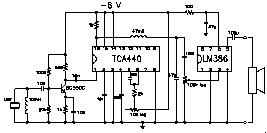This circuit may look simple, but that's because I made considerable effort to simplify the circuit. It requires only a small amount of components and it has low current consumption (15 mA).
Enhanced TCA440 bat detector

Introduction
From the left to the right, this circuit consists of a tranducer, a simple transistor pre-amp, a TCA440 IC that contains an oscillator and mixer, a second-order low-pass filter and a audio-amp consisting of a LM386 IC.You can download a few bat sounds recorded with this detector through my bedroom window.
Transducer
The transducer that is used is a piezo-electric transducer, which is quite sensitive but unfortunately has a relatively limited frequency range. By connecting a coil parallel to the transducer, the response can be broadened somewhat, at the expense of decreasing overall sensitivity.Pre-amplifier
The signal from the transducer is first amplified by a simple transistor stage, consisting of a single BC550C transistor. It is biased for a current of approximately 0.7 mA. The capacitor from the emitter to ground causes a +6 dB/oct gain slope for frequencies higher than 16 kHz. After this it enters the TCA440 at pin 1.TCA 440: Oscillator and mixer
In the TCA440 this signal is multiplied with the signal of a built-in tuneable oscillator. The oscillator can be tuned with the use of the potmeter connected to pin 6, from about 18 kHz to 100 kHz. The potmeter must be connected such that it has the lowest resistance when the wiper is turned counterclockwise. This gives a reasonable linear relation between wiper position and tuning frequency, but means that CCW is highest frequency and CW is lowest.The oscillation frequency is determined by the product of the capacitor between pins 5 and 6 and the resistor going from pin 6 to the positive supply connection. The highest frequency is therefore set by the 1n8 capacitor and the 2k resistor, while the lowest oscillator frequency occurs when the circuit sees a 2k+10k=12k resistor going from pin 6 to the positive supply connection. This means that the ratio between the highest and lowest frequency is equal to 12k/2k=6.
Low-pass filter and audio amplifier
From pin 16 the signal reappears and enters a low-pass filter. This is a second-order filter with a cut-off frequency of 3.4 kHz, giving a range of about 7 kHz around the oscillator center frequency.Finally the down-converted and low-pass filtered signal is fed into a LM386 audio amplifier which can drive a set of normal low-impedance headphones. I used a stereo 3.5mm jack chassis with the left and right leads connected together to give mono output.
Components
Components values aren't very critical, however I used metal film 1% resistors for the input stage. Also for the capacitor connecting pins 5 and 6 of the TCA440, you should use one with reasonable tolerance. For the 100uF and 47uF capacitors, I used electrolytics (watch the polarity !).Improvements
- Update! The value of the capacitor between pins 5 and 6 has turned out to be too low. A value of 2.7 nF (instead of 1.8 nF) is recommended. This improves the frequency range.
- In a future detector, I would exchange all 10 nF capacitors with 100 nF capacitors, to be sure that no signal is lost due to insufficient coupling
- The value of the coil parallel to the transducer is not optimal. A value of 8.2 mH or 5.6 mH is probably better suited to broaden the frequency range of the transducer. See also the page about detuning
This page was last updated Tuesday, December 28, 1999